A couple of days ago I finished up my last final examination for school, and now I’m done with the term. My final paper in one of my classes was on the Modoc Indian tribe. I have a personal interest, as there is a reasonable chance that my paternal grandfather was Modoc. I took this opportunity to learn about the people who may have been my ancestors. The paper is pretty long, so I divided it into parts for my blog. The first part I’ll include today.
In the times before there were dividing lines between states, the Oregon-California border held lands that were traditionally Modoc country. Several references describe Modoc territory as strictly south of the Oregon border, but this is inaccurate (Curtis, 161; Walling, 178). The Modoc are most associated with Tule Lake of northern California but also with Lower Klamath and Goose Lakes, that straddle the border, and Lost River, which flows through southern Oregon (Riddle, 15, 32). In fact the Modocs crossed so frequently between what is now California and Oregon, that it is better not to think of separate states at all, and merely use the border line as a general indicator of the location of Modoc Country.
Lands ceded as part of the 1864 Treaty signed by Modocs, Klamaths, and Yahooskin Paiutes, were described by Dennis Cooley, Commissioner of Indian Affairs in 1865, this way: “Parts of it are barren mountains and sage plains, of no agricultural value, but probably possessing great mineral wealth. Other portions are valuable for grazing purposes, producing a large amount of nutritious grass, but containing little or no land fit for cultivation. The valleys of the Klamath Lakes, Rhett Lake [Tule Lake], Goose Lake, Lost River, and seven others have much fertile soil. Some portions are well supplied with excellent timber, while in other parts there is very little” (Cooley, 102). It was described this way in 1924: “The western portion of this region is heavily forested, the central basin is dotted with lakes and marshes fed by the melting snows of the Cascade mountains percolating the porous volcanic soil, and on the eastern border sagebrush plains are characteristic” (Curtis, 162). This region experiences a much drier climate than that of the coastal tribes (Lewis, “A Short History”). Jesse Applegate, who moved to the area in 1843 with his brothers Charles and Lindsay, pointed out that despite the arid climate, for the most part there is no lack of grass and water at convenient distances (Walling, 203). While some areas such as river valleys can have a milder climate, summertime highs are very hot and wintertime lows are very cold (Cooley, 102). Having spent time in the area since my birth in Chiloquin and returning to visit my family just south of Klamath Agency, I can confirm that in the present day, it is much the same.
Neighbors of the Modocs were Klamaths to the north, Paiutes to the East, and Achomawi to the south. To the west were the Shastas, Karok and Taklema, and on the Pacific coast the Athapaskans (Tolowa, Umpqua, Chetco, and Tutuni). The tribes in this area lived most often in peace, but brief battles ensued between all of them (Walling, 181). Some sources claim that Modocs and Klamaths were particularly close. This connection may have been inferred due to shared language traits, which was a practice of early ethnographers. “Among the Rogue Rivers, Shastas, Klamaths, and Modocs,” A. G. Walling wrote, “are found strong race affinities, and they spoke dialects of the same language” (178). Curtis went so far as to describe them as one people, the Lutuami, divided into two groups, the Klamath and the Modoc, saying that the “language of the two divisions shows only dialectic differences.” The word Modoc is from the Klamath Móata-kni (móat, south; Móatak, Tule Lake; -kni, dwellers) (Curtis, 161). But perhaps the most compelling reason that the tribes are linked together is because it suited American hegemony. When the Modocs begged for a reservation on their own land, Ivan Applegate, Commissary in Charge at the Klamath Reservation, wrote on May 8, 1872, “These Modocs really are only a fragment of the Klamath Nation, having common sympathies, speaking the same language, and being closely intermarried with several bands on the reservations, and if located on a new reservation a constant and annoying intercourse would be the effect; and their success in being located there, in violation of treaty stipulations, would have a demoralizing influence on the other Indians” (Shanks, 261).
The Modoc Nation today describes the Klamath tribe as their traditional enemy. During treaty talks in 1864 and afterward, Modocs and Klamaths were not friendly with each other (Lewis “Bridge”; Riddle, 34; Sproull). This may have been a more recent development. Jeff Riddle, a Modoc who was well-connected to the history of the tribe, stated that “The Modocs lived in peace and harmony with all nearby tribes, including the Klamaths, until white people began to travel through their country” (Riddle, 15). He described an occasion when Klamaths and Modocs went fishing together on the Klamath reservation before the famous Chief Keintpoos left (Riddle, 37). There can even be found a legend that explains the breakdown between the two that occurred in 1800, when the Chief of the Klamaths demanded that a Modoc band turn over a portion of fish harvest to him. The Modocs refused, a declaration of independence was issued, and war followed with the Modoc victorious (Sproull). The tribes weren’t entirely antagonistic, however, because in times of war, the Rogue Rivers, Shastas, Klamaths, Modocs, and Umpquas fought side by side (Walling, 178). Curtis states that the Modocs warred with all their neighbors, including the Klamath, and the Klamath and Modoc were known to have fought together against the Achomawi (162, 163).
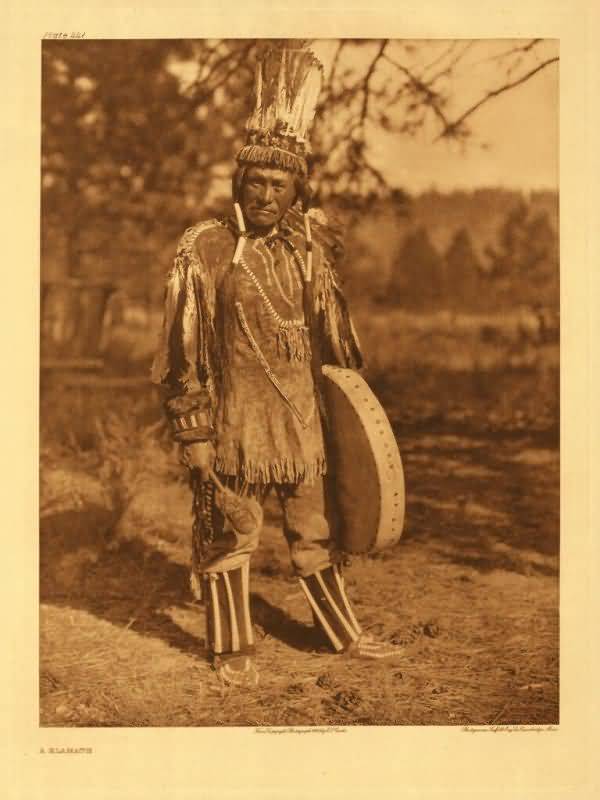
It is reported that in 1800 there were around 600 Modoc people (Sproull). In 1864 it was noted that 339 Modoc were present for the treaty talks, including men, women, and children. Cooley counted a combined 1,071 Indians from the Modoc, Klamath, and Yahooskin Paiute people present for treaty talks, representing a total of 1500-2000 Indians, including the people who were not present (102).
In their traditional homelands the Modoc followed a seasonal round, spending winter months around the lakes and along Lost River to the north and warmer months in the highlands beyond Medicine Lake to the south (“History;” Modoc; Shanks, 262). They were a trading people, and when white settlers and miners arrived, the Modocs honed their trading skills with them (“History;” Shanks, 261). They traveled through lava beds that lie between the mountains and the lakes, and were familiar with the caves and tunnels in that unusual landscape (Modoc; Curtis, 175; Riddle, 54). “The Lava Fields spread over 47,000 acres and have more than 700 caves. It has been a sacred site to Modocs for time immemorial. Modocs believe the land was created for them” (Horton). Rock art in the region is dated to 14,000 years ago (“History”).
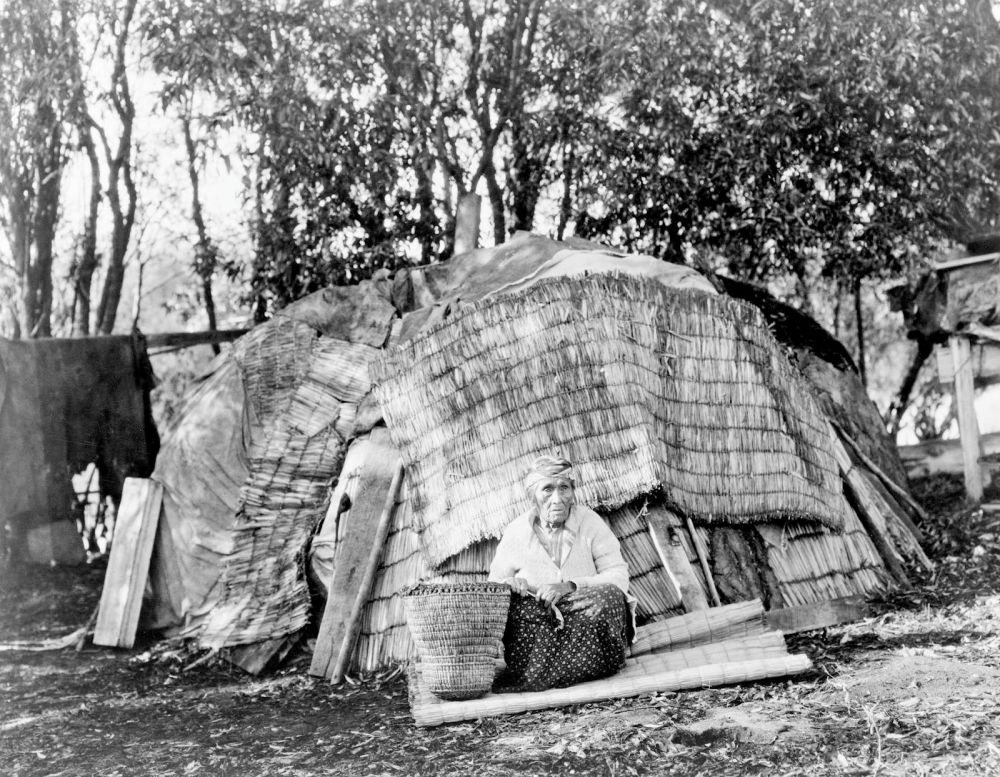
In warm weather, domed homes were constructed of tule reeds collected from the vast marshy areas in the region. Temporary summer houses were built by driving each end of light poles into the ground, or by driving in one end and drawing the upper ends together at the top. “These frames were covered with woven mats, and the ground beneath was sometimes scooped out and thrown up in a low circular embankment” (Modoc; Walling, 179-80). Winter dwellings had a circular pit, 2-5 feet deep into the earth, with poles driven into the ground around the outside of the pit. The tops of the poles were drawn together at the top to form rafters. The roof was thatched with tule, ferns, and grass, and then covered in earth. A hole was left in the top for smoke to escape, and for an entrance accessed using notched poles for ladders (Curtis, 166; Walling, 179). They also built larger structures for public assemblies using timber for greater strength, and they built sweat-houses for ceremonial use, such as in preparation for a hunt. The construction for both of these was similar to their houses, using thin poles for rafters, and then thatching the roofs. In his 1924 book, Curtis noted that there had been a shift to the use of blankets to cover sweat-houses (167). A film produced by the Klamath Tribes in 2017 shows a sweat-house design that uses bent poles covered with blankets (Klamath).
The shallow lakes and marshlands in Modoc country are responsible for much of their unique culture. In particular, tule reeds found in marshy areas around the lakes were an important resource for Modoc people. Tule reeds grow thickly and abundantly in the marshes of southern Oregon and Northern California. They are sturdy stalks that can grow ten feet tall. They have a strong outer shell that contains a spongey interior. The natural buoyancy made pieces of tule useful as floats for nets, which were made from nettle bark and also from tule fibers (Curtis, 170). Tule was woven into mats for walls of homes, mattresses, and linings in storage pits. It was used to build rafts and canoes, as well as clothing like leggings, hats, and sandals (Curtis, 165; Walling, 181; Modoc). Tule basketry included parching baskets, platters, bowls, cooking vessels, quivers, and a canoe-shaped floating basket for collecting wocas seeds. Tule baskets were flexible and designs were woven in using the dark tule roots and tule dyed with the shells of wocas seed husks (Curtis, 173).
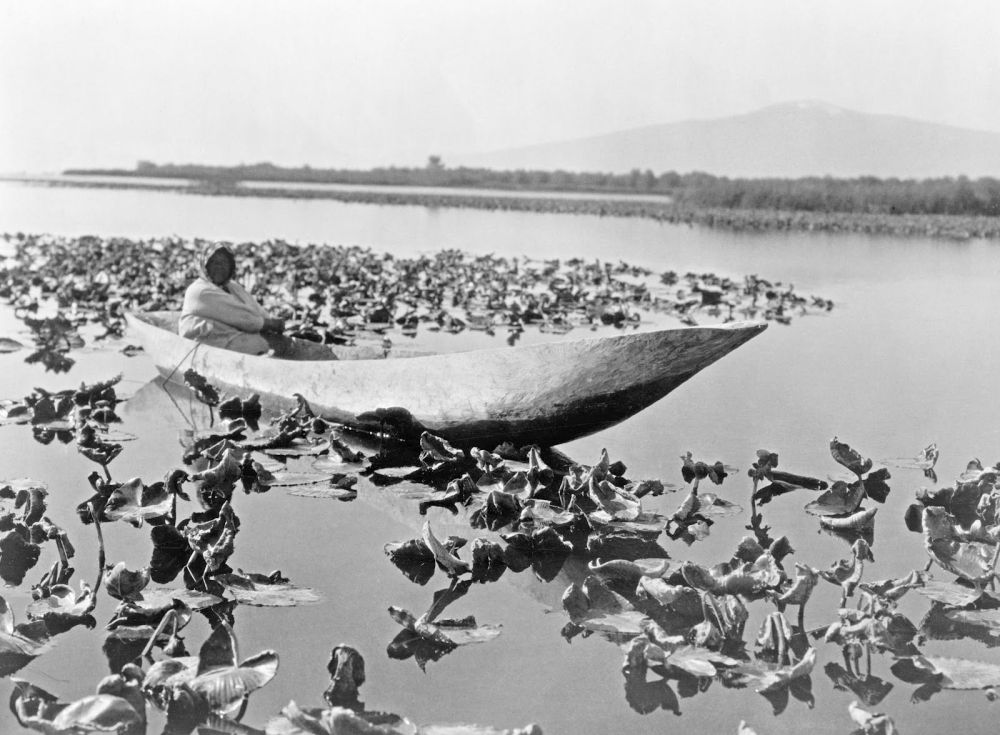
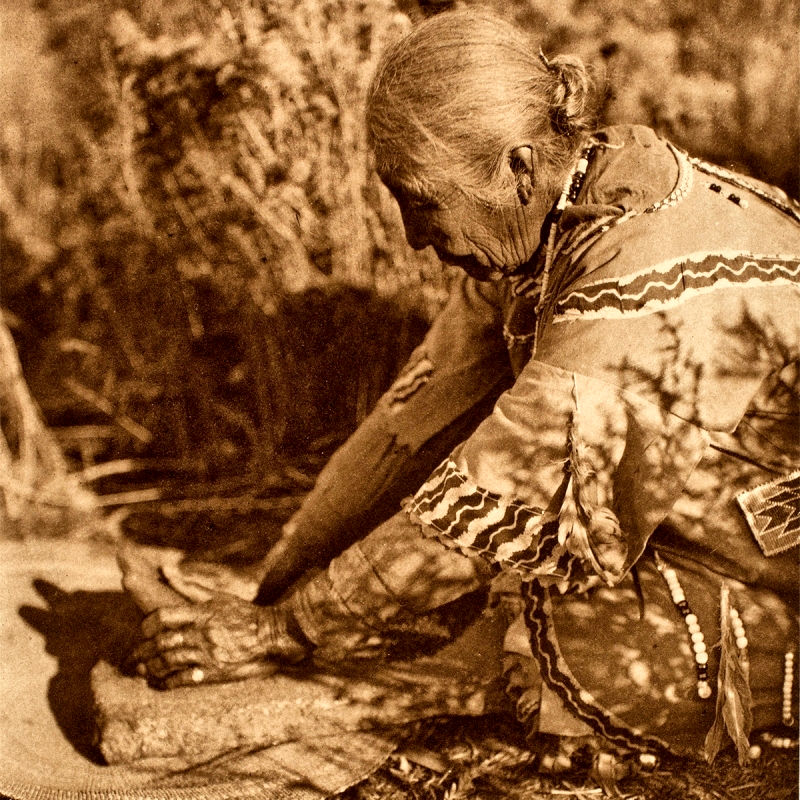
Wocas, or yellow water lily, also grew abundantly in the marshy lakes. The wocas seeds provided a main staple food supply for the Modocs, along with camas bulbs, mariposa and cattail roots (Curtis, 167; Walling, 180; Cooley, 102). Wocas seed pods were dried, sometimes by cooking them, and then the pods are split and seeds removed. Seeds were then dried and stored in baskets. They were prepared for meals by parching them over fire, or by grinding them into meal or flour with a metate (Modoc; Curtis, 168, 172). When possible the Modoc diet included bird eggs and a variety of berries and nuts (Walling, 180-81; Curtis, 169) Modocs were practiced hunters, shooting the plentiful waterfowl in the area with bows or tangling them with nets strung over ridgelines (Modoc; Curtis 170; Riddle, 15). They employed multiple methods of netting, hooking, or spearing fish. The Modoc would construct twig dams to collect fish for better spearing, or they would move through the water in dugout canoes, beating the sides to scare fish into a confined area, or into a net (Modoc; Curtis, 169-170; Walling, 180). Dugout canoes were crafted using fire and scraping to hollow out the inside of a tree trunk (Riddle, 47; Walling, 181). There are reports that the Modoc used torches to fish at night from dugout canoes and they also used fire at night to confuse waterfowl to fly into nets (Curtis 171; Walling 180). They hunted elk, deer, bear, mountain-goat, antelope and many smaller animals (Walling, 180; Curtis 169; Riddle, 15).
Clothing worn by Modocs in cooler months consisted of a “robe, moccasins, short leggings, and a loin-cloth” which were made of skins, tule reeds, or sagebrush bark. Some wore headbands and belts of eagle feathers (Curtis, 164-165). Men wore fur caps in winter and tule visor-caps in summer, and women wore woven tule basket hats (Curtis, 165). In warmer months, much of the clothing was discarded. Men wore breech clouts and women wore aprons or skirts of skin or woven grasses (Walling, 179). Both men and women wore braids (Curtis, 165-166). Most people had a perforated septum that was adorned on special occasions with dentalium beads. Dentalium shells from the Pacific coast, called ali-qua chick, were highly valued (Walling, 181; Curtis, 166). Most girls and some boys had pierced ears. Evidence of elders’ skulls showed that head flattening was practiced prior to 1864. Women had tattoos of three straight lines down from the corners and center of their bottom lip across their chin (Curtis, 166; Walling, 179).
The main social unit among Modoc people was the family, and the leader of each band was a chief. The status of chief was achieved by the man best fitted for the job, and when bands came together, chiefs would share authority, such as a war chief and a peace chief (Walling 182; Curtis, 175). Names reflected a characteristic of the child, such as Nóchoks (burnt [kinky] hair) and Keintpoos (strikes the water brashly) and these names were kept through adulthood. A dance was performed for a girl’s first menstruation. Boys and girls were sent to spend a night or two alone in the wilderness when they were 15-18. Upon returning, they would fast. Because of this vigil, the person would gain power such as luck or wealth, and some became shamans (Curtis, 177). Dead were cremated, and when the practice more recently changed to burials, possessions of the dead were burned, and in rare cases their homes were burned (Riddle, 31; Curtis, 178). When grieving, women and sometimes men would cut their hair, and all close friends and family would purify in a sweat-house together after the cremation. The name of the dead would not be spoken for several years (Curtis, 179).
*A note about photographer Edward Curtis. His images were romantic and often staged. For example, take a look at the woman grinding wocas seeds in finery. It is unlikely any woman would wear her best dress and beads while working. So, just take all these images with a grain of salt. It is about the best we’ve got in 2020.
{Please see the next post for the remainder of my paper, I discuss events between 1846-1873 in Modoc country, to try and understand what led to the Modoc War.}
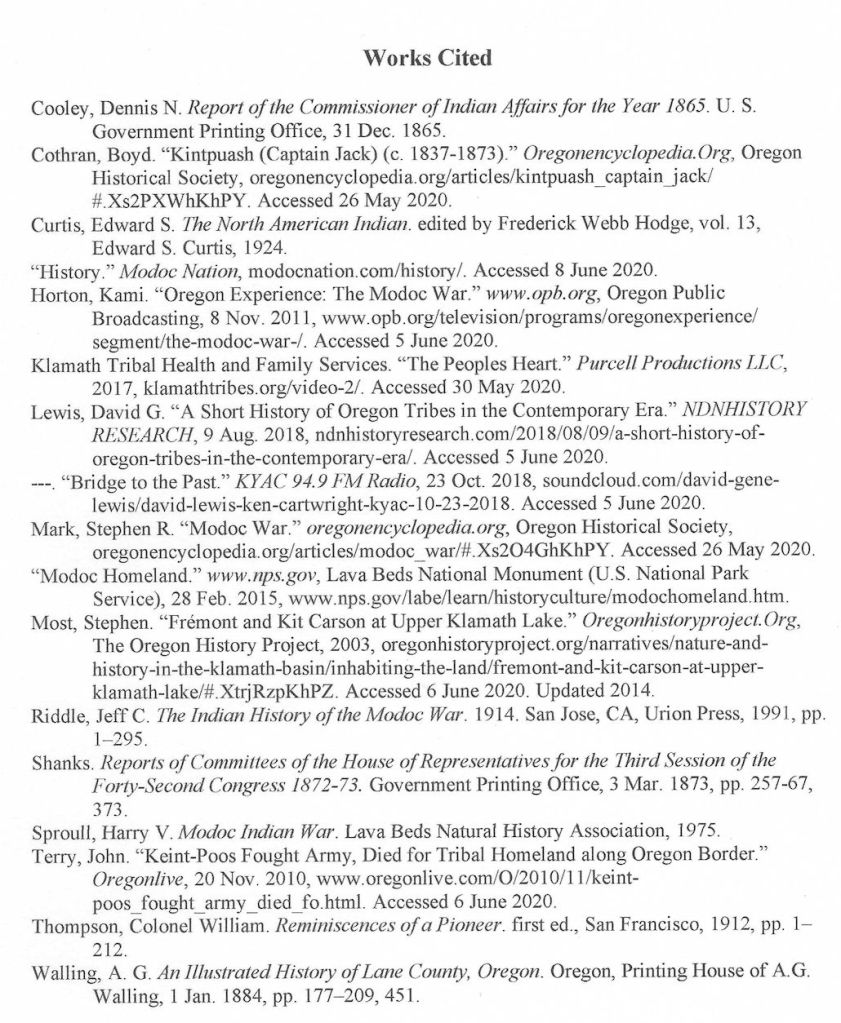
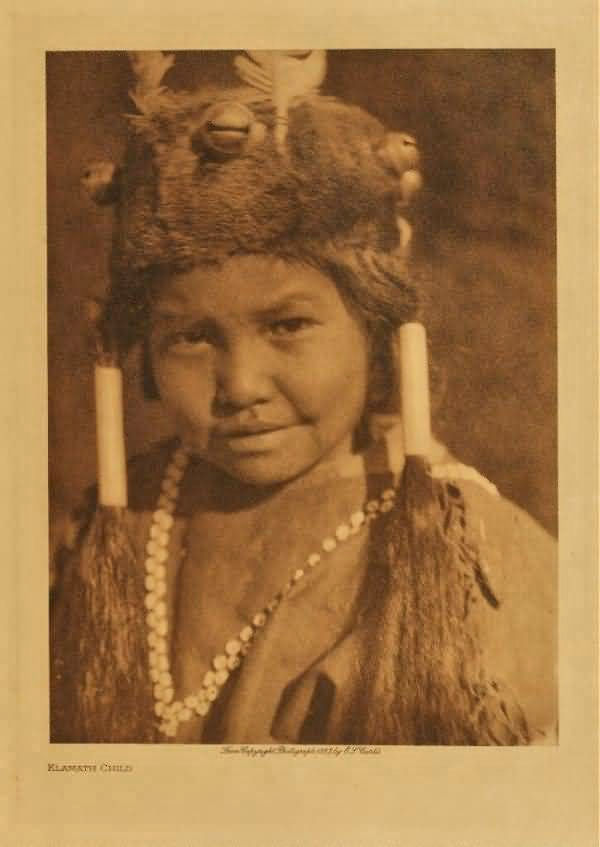


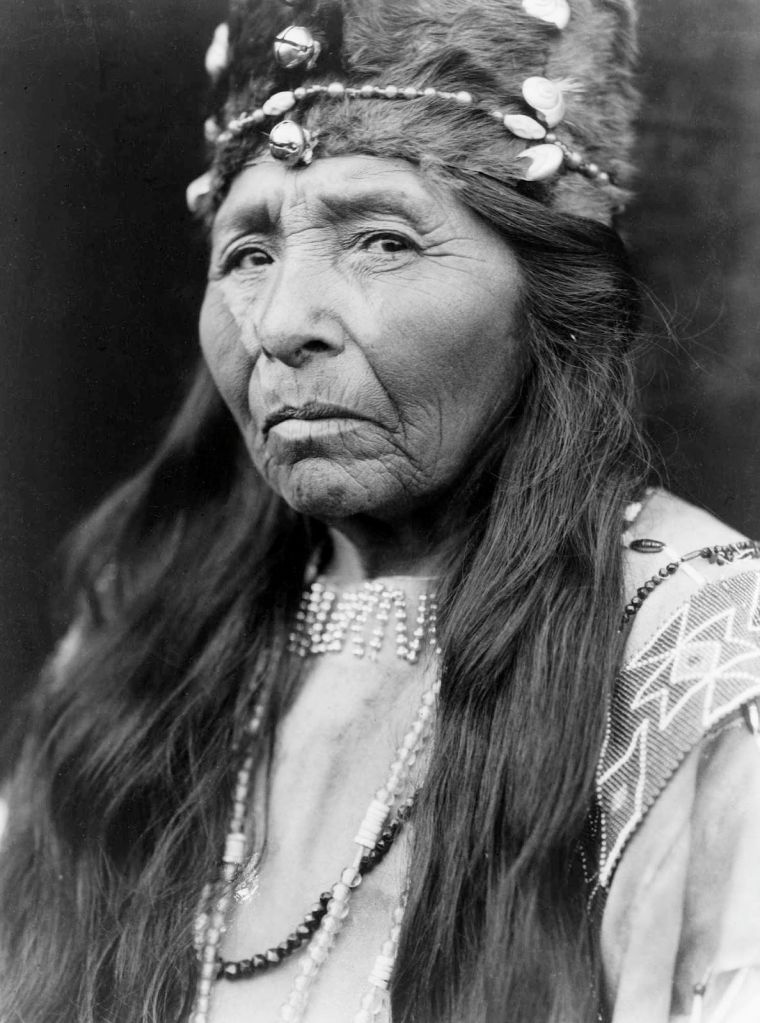
This was my very first post using the new WordPress block editor. It’s weird…but tolerable. I totally don’t see the purpose of this new system, it’s just more steps to do the same thing, with less flexibility, but whatever. Anyway, for the freegin LIFE of me, I cannot find a way to do italics. I can do superscript, subscript, bold, strikethrough (seriously?) but not italics. I’ll get this new editor figured out eventually. ….but seriously, WHY not include italics in the list of choices?
Very well researched with excellent pictures with an interesting narration. Many good wishes Crystal and good luck too🍀
Thank you so much for your interest. I was fascinated with the Modoc tribe, and that made the deep dive into researching them a fun project for me.
Such fascinating and important history with contemporary photographs. You have done well with the freegin new editor (did you get free gin when you typed that?)
No free gin! It’s a travesty. But worth a try anyway. So yes, I beat my head against the wall and managed to get a first post done with the new editor, and then the second one wasn’t really hard at all. That’s a good sign. Have you used it yet?
Thank you for agreeing that the history is fascinating and important. In my Indians class this term, we focused mostly on local Indian tribes, and I was astounded at how many different tribes were in this area. Just in the area that is now called Oregon, there were as many as 60 different tribes that were either based here or used the land. Each with its own customs and traditions. It’s hard to believe there was such variety. Today the US Census shows that people still identify themselves with 25 different tribes of Oregon.
I’ve been using the new editor for 3 weeks now. It is the best yet – but did my head in at first.
Ok, I’m glad to hear I’m not the only one who was confounded at first. Glad to hear it gets better too! Way to be a trail blazer!
🙂
Wow, Crystal. This is an impressive amount of research and very interesting. I now know a lot more about the Modocs! 🙂 I did a post on the petroglyphs of Lava Beds National monument. (http://wandering-through-time-and-place.com/2017/11/11/) Also our family is related to the Applegates by marriage. Lindsay is a family name. Good job. Thank you. I am looking forward to the next installment. –Curt
Thanks Curt! I knew you would like these Modoc posts because I’m talking about your home. Thanks for the link, I loved the post. Amazing that you are related to the Applegates. You aren’t even FROM that area, not originally, right? The Indians loved Lindsay Applegate. I think his son Ivan did a massive disservice to the Modocs, but you’ll read about that soon. Like I told Derrick, I was so fascinated by the Modocs that the research became fun. I found such wonderful resources, like Congressional Reports, and I even bought an original Harpers Weekly from 1873. It was so fun. Unfortunately, what I learned about their treatment was not fun at all.
The Mekemson’s and the Applegate’s got together back in Iowa in the early 1800s if I remember my family history right, Crystal. We, meaning my more direct ancestors of the Marshalls and Mekemson’s didn’t show up in Southern Oregon until the late 1800s early 1900s. My great great grandmother who is buried in Phoenix, Oregon came across to Washington in a wagon train, however. I had relatives on my dad’s side that actually lived over near Tule Lake in the late 1800s.
And no, sadly, there is very little history of how Native Americans were treated by white settlers that would classify as anything but tragic. –Curt
That means your family came to Oregon along with the original settlers then. Wow, I had no idea. I just always assumed you were from California, I guess, because of your time at Berkeley. That is really cool.
I was born in Ashland, Crystal and my Great Grandfather Marshall is buried in Jacksonville. He arrived in thew early 1900s and bought a pear orchard that is now a portion of Medford. Two of our family homes in Medford are on the National Historic list. 🙂 So, yep, I have roots. –Curt
Congrats on finishing the term. That is quite the lengthy research paper. I hope your grade reflects the amount of work you put in. I can understand why this was such an appealing subject for you. Now you get the summer off or do you have to start a summer term?
This is only the first part, so yep, it was pretty lengthy. This version is longer than what I turned in. I had to chop it down to meet the criteria. I always have that problem – I write too much. I am not going to take summer classes. And if school is still online in the Fall, I won’t take classes then either. I do not like school online. Takes half the joy of it away. This is my first week of freedom. I need to work on my newsletters, then I’ll be free for a visit if you feel safe enough having me come by.
This was really fascinating. Thanks for sharing.
I’m glad you liked it! Thanks so much for taking a look and leaving a message. If you want more about Modocs, take a look at the blog post right after this one.